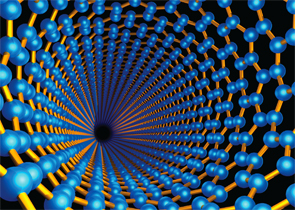
Nanotubes can penetrate the dense cartilage extracellular matrix, translocate into the cytoplasm of the chondrocytes and deliver mASO, and have staying power.
Forance/shutterstock.com
SAN FRANCISCO—Penetrating the dense extracellular matrix of cartilage is a challenge for administering osteoarthritis drugs, but an answer might lie in the matrix itself—in particular, its electrical charge, researchers reported at the 2015 ACR/ARHP Annual Meeting.
Electrical Affinity
Investigators at the Massachusetts Institute of Technology have found—at least in vitro and in animals—that delivering drugs on particles with an electrical affinity for this extracellular matrix (ECM) appears to overcome these barriers.
In cartilage ECM, aggrecan aggregate forms a kind of gel that fills up the spaces between collagen fibrils, said Alan Grodzinsky, ScD, professor of biological, electrical and mechanical engineering at MIT, who led the research.
“Any therapeutic that you’re trying to get to the cell or [to deliver] intra-cellularly has to wind its way through this matrix,” he said. “It’s very tough to get through.”
Intra-articular administration of the drug alone is not good enough; the drugs clear out of the joint space too quickly to have the intended effect.
But by using so-called charged nano-carriers, drugs can be delivered with rapid penetration and then bind to the ECM inside the cartilage. When that happens, Dr. Grodzinsky said, “the matrix becomes an intra-tissue depot delivery system rather than hindering transport into the tissue.”
Research carried out by Post-Doctoral Associate Ambika Bajpayee, PhD, turned to avidin, a protein with a high positive charge—attractive due to its size and because of the high negative charge of cartilage extracellular matrix.
In vitro studies showed that avidin had an uptake that was 400 times higher than its neutral counterpart, NeutrAvidin, in bovine cartilage as thick as human cartilage, and that more than 90% of the avidin that was absorbed remained in the cartilage for at least 15 days.1
‘There is still much room for improvement with the use of nanoparticles in drug delivery—particularly by specifically identifying ligands & receptors that could help promote particle & drug transport.’ —Dr. Bottini
“The avidin that was present upstream of the cartilage got sucked right in,” Dr. Grodzinsky said.
Subsequent case studies on rats and rabbits showed deep penetration and demonstrated the importance of cartilage thickness in retention of the particles.2,3
“Once you’ve loaded this material inside, due to electrostatic attraction, it leaves the cartilage at a rate that will depend on thickness,” he said.
Then researchers—with the ultimate goal of treatment after injury to prevent osteoarthritis—coupled dexamethasone with avidin and delivered the drug in vitro, using polyethylene glycol (PEG), the polymer most commonly used for drug delivery. They used both an ester linker, for faster release, and a hydrazone linker for slower release.4
“You have the ability to combine both fast release and slow release so you can get an early bolus release as soon as the avidin drags the dex in, and then a slower release during the subsequent time,” Dr. Grodzinsky said.
Cartilage explants were placed in a culture with inflammatory cytokines, and the solutions were injected with soluble dexamathesone; or avidin-dexamethasone with an ester linker; or avidin plus dexamethasone with hydrazone linker; or the avidin-dexamethasone-ester and avidin-dexamethasone-hydrazone in a 1:1 molar ratio. They found that the version with the best suppression of sulfated glycosaminoglycan (GAG) was the 1:1 combination.
“The concept is enhanced transport into the tissue because of charge, and then binding inside,” he said. “We’re now taking this into an animal and then going from there.”
Nanotubes
Massimo Bottini, PhD, associate professor of biochemistry at the University of Rome Tor Vergata, Rome, Italy, and adjunct assistant professor at the La Jolla-based Sanford Burnham Prebys Medical Discovery Institute, said there appears to be promise in the use of carbon nanotubes for intra-articular delivery of drugs straight to chondrocytes. In osteoarthritis (OA), chondrocytes have switched to a catabolic state. And the idea is to reestablish the balance between the anabolic and catabolic states by delivering gene inhibitors and/or gene activators.
Carbon nanotubes are very small cylindrical particles—as small as about 1 nanometer in diameter—that are known for their strength as well as their elasticity and conductivity. At Dr. Bottini’s center, researchers have tweaked them, including making them shorter and outfitting them with PEG, to make them biocompatible, biodegradable and more suitable to deliver their cargo of morpholino antisense oligonucleotides (mASO), used for gene inhibition.
Researchers found that, with just a single injection, the nanotubes were able to penetrate the dense cartilage extracellular matrix, translocate into the cytoplasm of the chondrocytes and deliver mASO—and had staying power once delivered.4
“Nanotubes persisted in the joint for more than 15 days in both healthy and OA rats,” Dr. Bottini said. “Importantly, they did not accumulate in major organs nor worsened OA per se.”
“There is still much room for improvement with the use of nanoparticles in drug delivery—particularly by specifically identifying ligands and receptors that could help promote particle and drug transport,” he said.
“The identification of ligands against cartilage extracellular matrix fragments or receptors expressed on OA chondrocytes,” he said, “will further improve the efficacy of nanoparticles carrying drugs aimed at reestablishing the chondrocytes’ homeostatic state.”
Thomas R. Collins is a medical writer based in Florida.
Second Chance
If you missed this session, it’s not too late. Catch it on SessionSelect.
References
- Bajpayee AG, Wong CR, Bawendi MG, et al. Avidin as a model for charge driven transport into cartilage and drug delivery for treating early stage post-traumatic osteoarthritis. Biomaterials. 2014 Jan;35(1):538–549.
- Bajpayee AG, Scheu M, Grodzinsky AJ, et al. Electrostatic interactions enable rapid penetration, enhanced uptake and retention of intra-articular injected avidin in rat knee joints. J Orthop Res. 2014 Aug;32(8):1044–1051.
- Bajpayee AG, Scheu M, Grodzinsky AJ, et al. A rabbit model demonstrates the influence of cartilage thickness on intra-articular drug delivery and retention within cartilage. J Orthop Res. 2015 May;33(5):660–667.
- Bajpayee AG, Quadir MA, Hammond PT, et al. Targeted intra-tissue sustained delivery of dexamethasone using avidin nano-carriers for treating cartilage degeneration. Osteoarthritis Cartilage. 2016 Jan;24(1):71–81.
- Sacchetti C, Liu-Bryan R, Magrini A, et al. Polyethylene-glycol-modified single-walled carbon nanotubes for intra-articular delivery to chondrocytes. ACS Nano. 2014 Dec 23;8(12):12280–12291.

